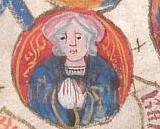Catherine of York
| Catherine of York | |
|---|---|
| Countess of Devon | |
 | |
| Born | 14 August 1479 Eltham Palace, Greenwich |
| Died | 15 November 1527 (aged 48) Tiverton Castle, Devon |
| Burial | 3 December 1527 |
| Spouse | William Courtenay, 1st Earl of Devon |
| Issue | Henry Courtenay, 1st Marquess of Exeter Edward Courtenay Margaret Courtenay |
| House | York |
| Father | Edward IV |
| Mother | Elizabeth Woodville |

Catherine or Katherine of York (14 August 1479 – 15 November 1527) was the ninth child and sixth daughter of King Edward IV by his wife Elizabeth Woodville. From birth to death, she was daughter to Edward IV, sister to Edward V, niece to Richard III, sister-in-law to Henry VII and aunt to Henry VIII.
Early life
The daughter of King Edward IV and Elizabeth Woodville, Catherine of York was born at Eltham Palace in 1479.[2]
During her early years, one potential husband for Catherine was John, Prince of Asturias, eldest son of Ferdinand II of Aragon and Isabella I of Castile.[3]
According to an agreement drawn up in 1487, Catherine would marry James Stewart, Duke of Ross, second son of James III.[4] This agreement was nullified with the death of James III in 1488.[4]
Marriage
In October 1495, Henry VII arranged a marriage between Catherine and William Courtenay.[2] They were parents to three children:
- Henry Courtenay, 1st Marquess of Exeter (c. 1496 – 9 January 1539)
- Edward Courtenay (c. 1497 – 12/13 July 1502);
- Margaret Courtenay (c. 1499 – bef. 1526) married Henry Somerset, 2nd Earl of Worcester
In 1500, Catherine and William Courtenay moved to their home on Warwick Lane.[3] After this point, the couple was regularly at court.[3]
Catherine was the chief mourner at the funeral of her sister, Elizabeth of York, in 1503.[3]
In 1504, William Courtenay was charged with treason in relation to his dealings with Edmund de la Pole.[2] Catherine remained at court.[2] William Courtenay was pardoned in 1509[5] and restored by Henry VIII in 1511.[2]
Later life
After William Courtenay's death in 1511, Henry VIII gave Catherine control of the earldom.[2] The title went to the couple's son Henry.[2]
On 13 July 1511, Catherine took a vow of celibacy in the presence of Richard FitzJames, Bishop of London.[6]
For the rest of her life, Catherine remained in the favour of Henry VIII. She was godmother to his daughter Mary.[2]
Catherine outlived all of her siblings by over a decade, dying in 1527.[5] She died at Tiverton Castle and was buried next door at St Peter's Church following an elaborate funeral.[7]
Arms
The arms of Catherine were her husband's arms impaling her own paternal arms: Baron: Quarterly, first and fourth: or, three torteaux (Courtenay); second and third: or, a lion rampant azure (de Redverd); Femme: quarterly, first: France modern and England, second and third: or, a cross gules (de Burgh), fourth (Mortimer).[1] These arms may be seen, exposed to the elements and thus very worn, sculpted above the south porch of St Peter's Church, Tiverton, Devon.
Ancestry
| Family of Catherine of York | ||||||||||||||||||||||||||||||||||||||||||||||||||||||||||||||||||||||||||||||||||||||||||||||||||||||||||||||||||||||||||||||||||||||||||||||||||||||||||||||||||||||||||||||||||||||||||||||||||||||||||||||||||||||||||||||||||||||||||||||||||||||||||||||||||||||||||||||||||||||||||||||||||||||||||||||||||||||||||||||||||||||||||||||||||||||||||||||||||||||||||||||||||||||||||||||||||||||||||||||||||||||||||||||||||||||||||||||||||||||||||||||||||||||||||||||||||||||||||||||||||||||||||||||||||||||||||||||||||||||||||||||||||||||||||||||||||||||||||||||||||||||||||||||||||||||||||||||||
|---|---|---|---|---|---|---|---|---|---|---|---|---|---|---|---|---|---|---|---|---|---|---|---|---|---|---|---|---|---|---|---|---|---|---|---|---|---|---|---|---|---|---|---|---|---|---|---|---|---|---|---|---|---|---|---|---|---|---|---|---|---|---|---|---|---|---|---|---|---|---|---|---|---|---|---|---|---|---|---|---|---|---|---|---|---|---|---|---|---|---|---|---|---|---|---|---|---|---|---|---|---|---|---|---|---|---|---|---|---|---|---|---|---|---|---|---|---|---|---|---|---|---|---|---|---|---|---|---|---|---|---|---|---|---|---|---|---|---|---|---|---|---|---|---|---|---|---|---|---|---|---|---|---|---|---|---|---|---|---|---|---|---|---|---|---|---|---|---|---|---|---|---|---|---|---|---|---|---|---|---|---|---|---|---|---|---|---|---|---|---|---|---|---|---|---|---|---|---|---|---|---|---|---|---|---|---|---|---|---|---|---|---|---|---|---|---|---|---|---|---|---|---|---|---|---|---|---|---|---|---|---|---|---|---|---|---|---|---|---|---|---|---|---|---|---|---|---|---|---|---|---|---|---|---|---|---|---|---|---|---|---|---|---|---|---|---|---|---|---|---|---|---|---|---|---|---|---|---|---|---|---|---|---|---|---|---|---|---|---|---|---|---|---|---|---|---|---|---|---|---|---|---|---|---|---|---|---|---|---|---|---|---|---|---|---|---|---|---|---|---|---|---|---|---|---|---|---|---|---|---|---|---|---|---|---|---|---|---|---|---|---|---|---|---|---|---|---|---|---|---|---|---|---|---|---|---|---|---|---|---|---|---|---|---|---|---|---|---|---|---|---|---|---|---|---|---|---|---|---|---|---|---|---|---|---|---|---|---|---|---|---|---|---|---|---|---|---|---|---|---|---|---|---|---|---|---|---|---|---|---|---|---|---|---|---|---|---|---|---|---|---|---|---|---|---|---|---|---|---|---|---|---|---|---|---|---|---|---|---|---|---|---|---|---|---|---|---|---|---|---|---|---|---|---|---|---|---|---|---|---|---|---|---|---|---|---|---|---|---|---|---|---|---|---|---|---|---|---|---|---|---|---|---|---|---|---|---|---|---|---|---|---|---|---|---|---|---|---|---|---|---|---|---|---|---|---|---|---|---|---|---|---|---|---|---|---|---|---|---|---|---|---|---|---|---|---|---|---|---|---|---|---|---|---|---|---|---|---|---|---|---|---|---|---|---|---|---|---|---|---|---|---|---|---|---|---|---|---|---|---|---|---|---|---|---|---|---|---|---|---|---|---|---|---|---|---|---|---|---|---|---|---|---|---|---|---|---|---|---|---|---|---|
| ||||||||||||||||||||||||||||||||||||||||||||||||||||||||||||||||||||||||||||||||||||||||||||||||||||||||||||||||||||||||||||||||||||||||||||||||||||||||||||||||||||||||||||||||||||||||||||||||||||||||||||||||||||||||||||||||||||||||||||||||||||||||||||||||||||||||||||||||||||||||||||||||||||||||||||||||||||||||||||||||||||||||||||||||||||||||||||||||||||||||||||||||||||||||||||||||||||||||||||||||||||||||||||||||||||||||||||||||||||||||||||||||||||||||||||||||||||||||||||||||||||||||||||||||||||||||||||||||||||||||||||||||||||||||||||||||||||||||||||||||||||||||||||||||||||||||||||||||
References
- ^ a b "The House of York". Richard111.com. Archived from the original on 4 March 2016. Retrieved 7 October 2016.
{{cite web}}: Unknown parameter|deadurl=ignored (|url-status=suggested) (help) - ^ a b c d e f g h Levin, Carole; Bertolet, Anna Riehl; Carney, Jo Eldridge (3 November 2016). A Biographical Encyclopedia of Early Modern Englishwomen: Exemplary Lives and Memorable Acts, 1500–1650. Taylor & Francis. ISBN 9781315440712.
- ^ a b c d Weir, Alison (3 December 2013). Elizabeth of York: A Tudor Queen and Her World. Random House Publishing Group. ISBN 9780345521385.
- ^ a b Stevenson, Katie (30 May 2014). Power and Propaganda: Scotland 1306–1488. Edinburgh University Press. ISBN 9780748694198.
- ^ a b Panton, James (24 February 2011). Historical Dictionary of the British Monarchy. Scarecrow Press. ISBN 9780810874978.
- ^ England), Cambridge Antiquarian Society (Cambridge (1859). Antiquarian Communications. Macmillan.
- ^ Edited by Todd Gray, Margery Rowe and Audrey Erskine (1992). Tudor and Stuart Devon: The Common Estate and Government. Published by University of Exeter Press. p. 13.
{{cite book}}:|author=has generic name (help); Cite has empty unknown parameter:|1=(help)
Sources
- familysearch.org. Retrieved 26 January 2008
- Plantagenet family. Retrieved 26 January 2008
